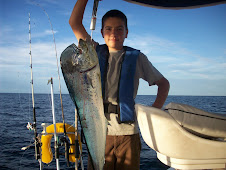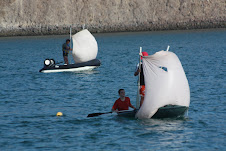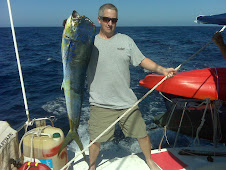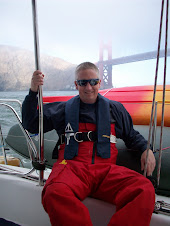Our first day back on the boat after our trip home dawned cool and cloudy, so Patrick and I jumped up early to get some work done. The first thing on the list was to wash five weeks of town dust off of our boat. Santa Rosalia's main employment is a copper mine and so the town has an inordinate amount of grime - even for a Mexican town.
We did a thorough washing job and finished up a few hours later. Then thirty minutes after we had finished washing, a 50+ knot Chubasco hit us. One minute we were looking up to see the brown haze to the south, with not a breath of wind in the air, and the next minute we were enveloped in an instantaneous 50 knot wind that was loaded with dust and grit. The wind had evidently traveled over the mine on its way to us. This Chubasco was masquerading as a Sahara dust storm and it did a really good job of it. Three hours later when the winds stopped our boat was dirtier than when we had started cleaning it.
A Chubasco is a type of wind storm created by the extreme convection in the Sea of Cortez, the cooler sea air and the hot air over land create extreme storm cells that travel quickly and can have winds over 60 knots. I've seen Chubascos more often at night since they are easy to spot with lots of lightning, but they can happen any time. They are very localized and you only experience the effect if it is near you. This type of storm is probably what caused the
charter fishing boat to capsize and sink, causing the death of seven Americans, a few months ago up north in the Sea of Cortez.
When the Chubasco hit, suddenly the docks were filled with people checking their boats and the boats that were unattended. One unattended boat had all four of it's fenders pop from the impact of the wind and its bow sprit was getting raked on a piling. Several people worked to retie it and we donated a fender that we weren't using to help hold it off the piling. Another boat was pushed over at about 20 degrees against the dock - just enough to make their fenders useless and to scratch the heck out of their striping and port windows. Seven people pushed like Hercules to get enough space to raise the fenders up and retie them. Our boat was tied up all goofy because we had just repositioned the bow closer to the dock so we could do some work on the anchoring system. Of course, we hadn't retied it very well since we were planning to complete the work within an hour or two and then we would have retied correctly. No problem as long as the weather had cooperated. All of the weight of our boat ended up on one cleat. Not good. I kept expecting it to snap off at any minute. We spent quite a bit of time digging out more lines and even moved an unused cleat from another section of dock over to our side to help hold our boat to the dock.
It was quite a welcome home. Since then, we have continued to put the boat back together and provision up for the summer up north. We just got back from a few days anchored at a nearby island. We wanted to do a quick run-through to make sure everything was working correctly before we left for the wilds of the North Sea of Cortez. We put the headsail back on, re-commissioned the dinghy, un-pickled the water-maker, cleaned the boat bottom, unwrapped the main, and stored away our luggage. It was nicer to get that work done somewhere where you could jump in the water every couple hours to cool off. It takes a lot of work to put your boat back together in working order after an absence.
Our work is done now and this is our last day in Santa Rosalia where we are tying up the last few loose ends. Tomorrow we leave! I'm always excited when we leave dock, but I'm also anxious this time. It's easy to get lulled into a false sense of security. Day after day the weather is hot, it's windy but it nothing you can't handle. Then when you see a storm like the Chubasco hit without warning and with such ferociousness, your false sense of security gets ripped away. And that's a good thing. It's when you let your guard down that things can go very wrong.

































